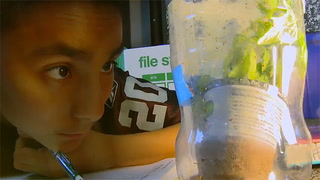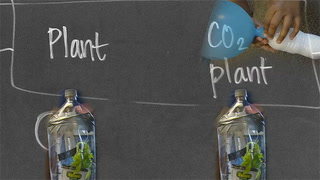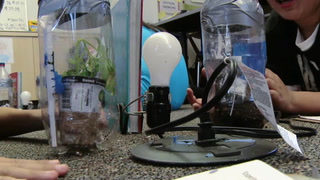Classroom Close Up: Climate Change in a Bottle - The Set-Up
With Suney Park
[01:00:11;06]
Suney: "On the count of three, move the desks to the back, get your materials, and setup your stations. What happens with science? What's the hardest part in an experiment?"
Student: "Trying to set it up."
Suney: "Set it up because some things are just not gonna work, and you know what, something might not work today."
Student: "It's not working. Suney!"
Suney: "There's a chance that nothing's gonna happen to any of the temperatures. Well, we don't know. As scientists, we need to be flexible. Everyone be flexible. We need to be flexible, and we need to say to ourselves, you know what, if something doesn't work, that's part of the process, and then we can make it better for next time."
Before doing the experiment, we had to talk about the setup. And, not just like let them go right away, but we had to really um, make it so it was broken down into steps. OK, so first, we're gonna take our bottle.
"At the front of the room, we have bottles with the cap. The caps need to be put on. It's gonna be a closed system."
Second, we're gonna cut off the top.
"You're gonna have two bottles, make them the same, as close to the same as you can. You're gonna take a pair of scissors, and carefully, in the most scholarly way, you're gonna puncture with one of the ends here, your first hole, and we want it in the first, um, we want it at about 75%, 3/4ths of the way up. Remember we want it a little bit higher up. Why did we want it a little higher up? What was the problem?"
Students: "So, we could see..."
Suney: "'Cause then the thermometer wouldn't fit, that was right. Right. And, then after that, if you are a plant person, you're gonna put one of the thriving plants in and then you're gonna put whatever else you need too, your thermometer, put your thermometer facing outward, and you're gonna tape it more towards the top with a piece of the blue tape. Make sure it's secure."
Student: "Hold it."
Student: "Um, we used the black tape because the blue tape wasn't sticking as good, so we decided to use the black tape. And, we're also gonna use the black tape to um, seal the bottle."
Suney: "OK, black tape, you're gonna seal around it. You're gonna close your system. Please don't let any air come out. We want to really make it tight and secure. And, then we're gonna put the extra layer of everyone?"
All: "Duct tape!"
Suney: "Duct tape around that."
Student: "Let's treat it like a baby."
Suney: "It's gonna be completely closed. At that point, the carbon dioxide people..."
So we created carbon dioxide by mixing together baking soda and vinegar and right away, the reaction happens in the water bottle, and then the carbon dioxide rises and fills the balloon.
Student: "Oh, Lord!"
Suney: We also could have ordered a CO2 tank, and we could have just done it that way, but I think any way that makes the kids more involved, and have control is better.
"As best you can, you're gonna put the bo, the CO2 in, and as quickly as you can, you're gonna close it."
"OK, are you girls ready? OK? So, say 'Execute!'"
Students: "Execute"
Suney: "Quickly as you can. OH!! Wow! That was great! Oh my gosh!"
Student: "I felt it!"
Suney: "That was fantastic!"
"OK, close it tight!"
Student: "We're about to do our clamping."
Student: "We're at the process of doing the lamp."
Suney: "Everybody needs to be on the floor, I want light bulbs down. I don't want anybody touching anything. OK, listen. The number one mistake made with this experiment - somebody gets up, trip over a cord, knock down the light bulb, they're done. So, we need to stay in our seats. The second thing, now watch what I'm gonna do to read the temperature. You are going to go on the ground like this, and you're gonna look at it straight on, straight on. And I'm gonna say this to my partner, this is what I'm gonna say '24!' You're gonna confirm it. The person next to you is gonna say 'Yeah, 24.' And, practice getting into this position, right now. Any questions? Any concerns?
Now, in a minute, it's gonna be kind of a little bit chaotic in here, but it's gonna be purposeful chaoticness."
You can let them go. The room is going to be really loud, but it's OK because it's a purposeful chaos. I don't expect them to be, you know, little robots and everything gets done with quiet. There was a time in my career as a teacher where that wasn't OK, and it made me feel like so...something was out of control, but I've learned that there is a control that might not look like it, but that it is actually. The other choice was to have these systems already setup, like I could have, with a couple of students after school, have made all of the bottles myself. And, it would be a lot cleaner, take a lot less time, more peaceful, but I think there's uh something meaningful about creating everything, even if you make a mistake, even if you're room's gonna, like totally smell nasty, and be messy, it's, it's part of the fun.
Student: "Take that data, Naya!"
Student: "Good luck!"
Suney: They love to learn. I let go of my own need for order to let them experience that.














5 Comments
Sherry Thomas Sep 17, 2017 4:50pm
Lynne Gayler Nov 14, 2016 7:35pm
Amanda Amburgey Mar 13, 2016 4:15pm
Nicole Sendejas Mar 26, 2015 5:31pm
Rod Campbell Jul 12, 2011 12:16pm